Good day! Well, I’d rather see this day a good one than complaining about the warm weather because I finally learned how to bun my hair. Right. I don’t know how to bun my hair until today. I am forced to learn how because the heat is feels irritating and annoying. It’s a super messy bun though, but at least I have all my hair up and it feels less warm now. (Hehe!)
Summer makes me want to return to Baguio City. I want to feel the cold weather again and see those fogs hovering on the trees like those around the cultural place that I am writing about today—the Tam-Awan Village!
THE TAM-AWAN VILLAGE
Tam-Awan Village was established by Chanum Foundation, Inc. in 1998 and has a total land area of 2.5 hecatres. The Tam-Awan Village showcases authentic huts from different areas of Cordillera region like the Nagor, Kinakin, Dukligan, and Anaba from Ifugao and the Luccong and Bugnay from Kalinga. Aside the huts, the village is also a haven for art lovers as this place features the colorful and creative art of the region by local artists. Visitors also get to experience a sneak peek on the culture, art and history of Cordillera on a more accessible area which is an advantage for those who don’t have the opportunity or time to explore other areas of the region. A very nice concept of bringing the culture and indigenous environment within the city.
(video source: tamawanvillage via Youtube)
Tam-Awan Village overview.
"Tam-Awan" means "overlooking" in their dialect. They said reaching the top of the village will reward you a beautiful view of Baguio City and some nearby provinces. Thus, also being called Garden in the Sky.
GOING TO TAM-AWAN VILAGE
The Tam-Awan Village is at the Pinsao Proper, northwestern side of Baguio City. A bit opposite to our last destination, Bell Church. We were supposed to take a taxi cab from Bell Church to Tam-Awan Village but all taxi cabs passing by were occupied. We lost hope after waiting for 30 minutes so we rode a jeepney back to the city proper to find the jeepney that is bound to the village. After a very tiring walk, we had finally found the jeepney on the Baguio City Public Market area.
Take the jeepney with the Long Long-Tam-Awan route or the one with Quezon Hill-Tam-Awan route which we rode on. The jeep with the Quezon Hill route won’t take you exactly in front of the village. The end of their route is several meters before the village so you have to work your feet a little more before you can reach the village. I remember the jeepney driver pointed at a green house and said after it is the Tam-Awan village. We got nervous and thought we got lost when we saw what’s next to the green house was nothing but another house. Thank goodness we walked further and found the village. (Haha!)
Going to Tam-Awan Village is a bit challenging if you don't know where the exact terminals of these jeepneys are. And once you are in the jeepney, make sure you have something to hold on tight because the road going to the village felt almost like a roller coaster (well, for me).
The travel time was about 15-20 minutes and fare was Php 8.50. We left the Baguio City Public Market at around 3 P.M. and arrived in the village around 3:20 P.M. So what did we do after we left Bell Church at 11:45 A.M.? I’ll let you know on my next blogs.
ARRIVING AT TAM-AWAN VILLAGE

(image source: Katsanslimites)
Huge Tam-Awan Village logo at the village's walls.
Tourists will surely get amazed at Tam-Awan Village’s facade as it gives a clear representation of how vivid and artistic the Cordilleran art is. The logo of the village consists is a hut. Although I don't know why the huge logo outside has two lizards on each side. I wonder what lizards mean in their culture and how important it is to them.
Entrance fee is Php 50 and there is no time limit of staying inside. So you can spend your whole day here if you wish. And thank goodness the lady at the booth agreed to keep our heavy backpacks. We sighed in so much relief because the place will have you walk around on steep and slippery rugged stairs. And before I forget, wear your most comfortable shoes for this trip.
While paying our entrance fee, I already caught sight of a huge lizard art on the side. I’m not fond of lizards so I was initially frightened (a little) when I saw it. But as I stared at it closely, I saw beautifully painted patterns on it. Wow.
(video source: Wood Culture Tour via Youtube)
A detailed explanation on some of the huts inside Tam-Awan Village.
Tam-Awan Village has a couple of huts from Ifugao and Kalinga. So if you don’t want to travel far to see each, then head to this village as they have it gathered here in one place. The village also have huts where you can lodge in to experience how it feels living like the indigenous people of Cordillera. (I can't share any photo of the huts because I was only able to snap one and unfortunately, it was blurred. Sorry.)
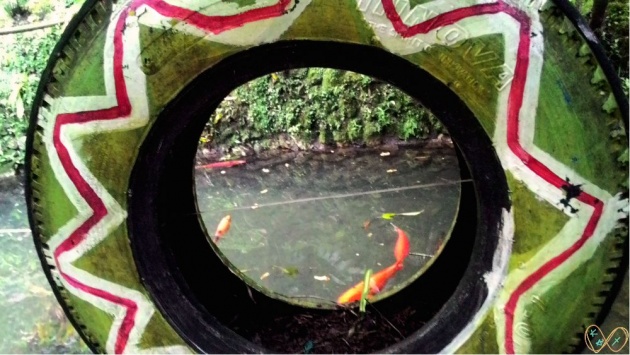
(image source: Katsanslimites)
A pond filled with koi fish.
They also have a bonfire area near the entrance and a few steps above is a pond filled with koi fish. I’ve also seen a couple of coins under the waters of the pond. This probably serves as a wishing well, or wishing pond? Well, another nice thing on the pond area is the fence where they used old tires and painted them colorfully.
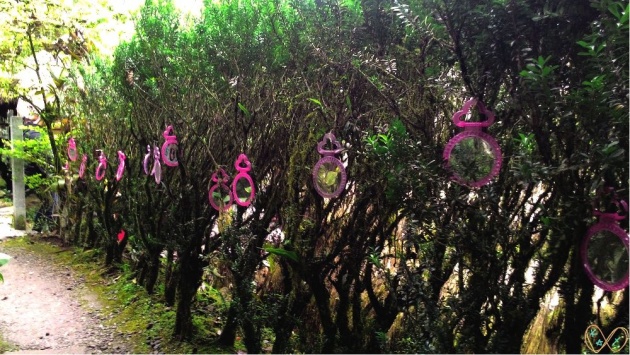
(image source: Katsanslimites)
Mirrors hung on trees.
Aside from those, they also have an area full of pink and violet mirrors. Seeing lots of mirrors hung on trees gave me an eerie feeling but seeing some of them broken brought me more chills. (Haha.) Anyway, this area is called "Reflection" and the thought of this mirrors is to reflect on ourselves; our past, present and future self. The tree represents the life cycle and also emphasizing the relation of man with nature.
I’m now halfway my blog but it seems like I still haven’t described how the village looks like inside. (Hehe.) The Tam-Awan Village is filled with trees and plantswith uphill areas which requires you to take the rugged stairs. Climbing up the stairs felt like hiking for me. Some steps were small and some were a bit high. It was a bit slippery too, so be extra careful on this areas.
Aside from that, the surroundings felt like a forest for me. It’s super quiet that only the rustling of the leaves and chirping of the birds could be heard. The super quiet environment and forest-like vibe scares me a little but hey, maybe this is how it’s like being on the village of the Cordilleran natives. So it’s really good that we get to experience it. And sometimes, you'll hear the gongs being played from afar at the performance area too. It makes you feel like you're on the exact community of the natives.

(image source: Katsanslimites)
A short hanging bridge made of bamboo.
There’s also a short wooden hanging bridge once you’ve climbed up to the upper part of the village. The bridge has a big peace symbol on it too. Maybe a message that they are a peace-loving community.
Climbing up the stairs feels exhausting but no worries because along the way, they had also set up some gazebo for you to rest on before heading to another walk.
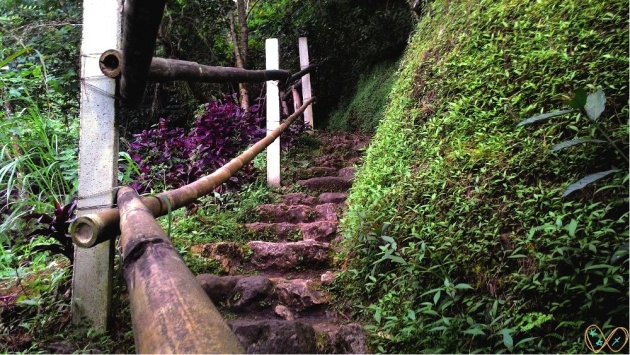
(image source: Katsanslimites)
The highest part we had reached on the village.
The highest point of the village we had reached was just a few feet from that gazebo (Lol.) We were too tired already and the trail seems to be unending. Very few were going further the gazebo too. Although they said that when you’ve reached the top of the village, you’ll get a nice view of Baguio City and nearby provinces like La Union and Pangasinan—and the South China Sea/West Philippine Sea? Whoa!!!
After the hiking-like experience, we went down and looked for their cafe to eat because we still haven’t eaten our lunch. Yes, we haven’t eaten any food since we left the transient house. All we had was a bottle of water. (Lol.) That’s about 7 hours of no food, not to mention we kept on walking and was even burned under the sun in La Trinidad.
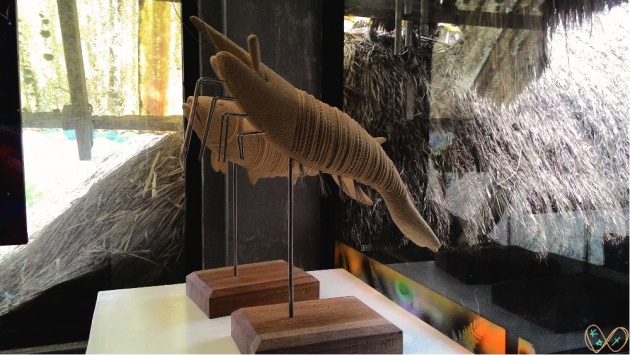
(image source: Katsanslimites)
One of the many art pieces displayed inside the cafe.
Entering the cafe gave me a very happy feeling as everything around is adorned with artistic pieces. Paintings were everywhere and other beautiful art crafts were also displayed on one corner. The chairs and tables are also made of wood. Everything inside the cafe exudes a very ethnic vibe.
Excited and hungry as we were, we immediately took our seats and ordered something that would fill our starving stomachs.
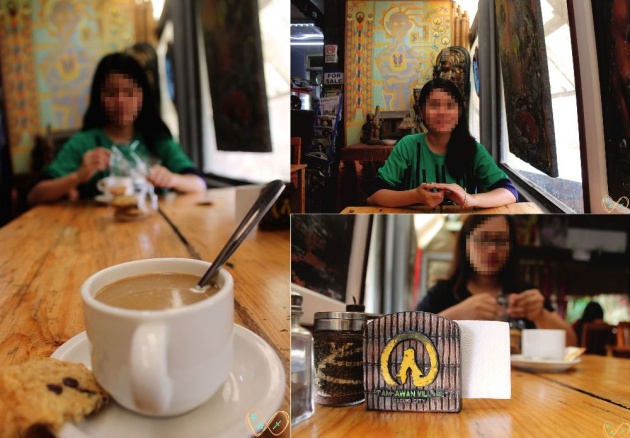
(image source: Mhaiiiself; edited by Katsanslimites)
Our lunch for the day! Oh no, we're not hungry at all! (Lol.)
Voila! The "BUDGETarian" meal, everyone! Surprisingly, the price on their menu was quite expensive. Expensive for us poor humans. (Lol.) No, we’re actually on a cheap travel so we have to budget our money and spend little as much as possible. Anyways, since it may take sometime before we return here (hopefully), we tried their Benguet Blend Brewed Coffee which costs Php 55 and a pack of Oatmeal Cookies for Php 60. Both tastes good although the coffee tasted a little bitter. I don’t drink coffee so maybe that’s why the taste felt a bit bitter for me.

(image source: Katsanslimites)
A photo together with the Cordillerans after their traditional dance.
Beside the cafe, is a little area where you can watch their traditional dances. This is also my first time to see a Cordilleran man wearing a bahag (loincloth). One thing I could admire is their flawless skin. (Like how do they achieve that? Lol.)
You can also join them dance if you want. I remember a white guy sitting nearby our table at the cafe ran out to join the dance when he heard the gongs playing. It’s a bit hilarious because he immediately went out and even left his laptop turned on at the table. Good thing the village is a nice community. But please, don't leave your things unattended when you're in public.
They also allow visitors to take photos with them after the performance. And as a gratitude for the opportunity, you can drop any amount you're willing to give on their donation basket.
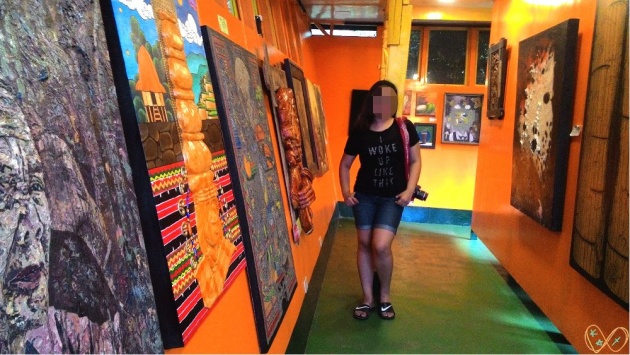
(image source: Katsanslimites)
At the art gallery with mhaiiiself.
And beside their little performance area, there is a small art gallery which showcases the art of some local artists. Some were painted, some were made of carved wood and some were made of metal. Different medium and different styles, but they all look so good and magnificently made.
Tam-Awan Village also conduct art workshops but we haven't found where that is. They also sell paintings or you can have an artist draw a portrait of yourself. I wonder on what area can they be found because the village is huge and we haven’t seen everything around.
A VILLAGE LIFE WITHIN THE CITY
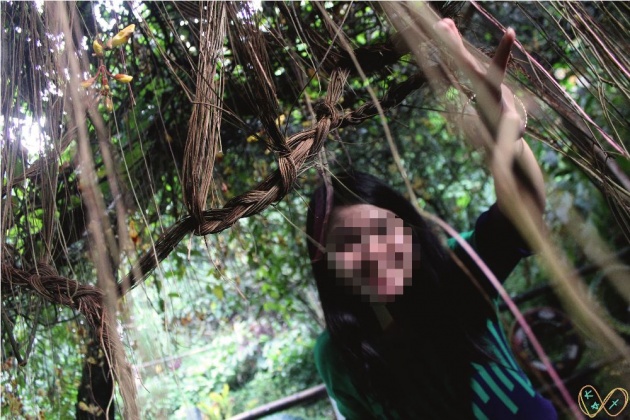
(image source: Mhaiiiself; edited by Katsanslimites)
A little photoshoot before we left the village. Thanks mhaiiiself! (Haha!)
Tam-Awan Village is one of the best places we have been on this travel. It was nice experiencing a bit of Cordillera’s culture and art in one place. Their home, art, people, dance, food, etc. I quite love this place. A recommended place for people wanting to visit something not so known to tourists in Baguio City. It’s good for a family trip although elders might have a difficult time climbing up. But they can surely enjoy the cafe, art gallery and watching the dances, so it’s good!
I don't know a place like this exist in Baguio City until mhaiiiself recommended it for our trip. I'm glad she found out about this wonderful village.
Thanks for reading!
✧ Katsanslimites



